Remanufacture, refurbishment, reuse and recycling of vehicles: trends and opportunities
This report describes the short, medium and long term trends related to the remanufacturing, refurbishment, reuse and recycling of vehicles, parts and components in Scotland.
4. Wider review of practices and technologies available
This section includes a wider review of practices and technologies currently use in ELV dismantling, shredding and post shredder treatment. Some of these practices and technologies are currently used in Scotland and others can be found in different geographical areas. Before describing these technologies it is useful to consider one of the fundamental issues in the recycling and recovery from ELV: the optimal balance between dismantling and shredding (and the use of Post Shredder Technology ( PST)). Practices and technologies used for dismantling, mechanical shredding and PST treatment of ASR are then discussed. Finally, a summary of technologies used in the recovery of rare earth and valuable metals is provided.
4.1 Optimum balance between dismantling and investment in PSTManual dismantling of parts and materials from ELVs can achieve a certain level of recycling and recovery but feedback, from many in the industry, suggests that achieving the 95% target by 2015 will only be economically possible through investment in PST treatment of ASR. This extract from a relevant study [41] illustrates this view:
"Pro-active European investment would suggest that post-fragmentation material recovery is the preferred option for achievement of the higher recycling and recovery levels...... It is widely perceived within the vehicle recovery sector that the economics of manual material removal is not viable based on UK labour wage rates. "
The study found that if ELV operators were to meet the 2015 recycling target by increased manual dismantling alone ( i.e. assuming no improvements in post shredder technology - from the time of this 2006 study) then this would be done mainly by the removal of plastic and rubber components totalling 5%+ of the ELV weight. The study found that this would cost the ATF 12 Euro per ELV (taking into account the price received for the recovered material less labour and transport costs). Considering dismantling of only those components where it was economically feasible to remove, this would result in 0.75% of the ELV weight being extracted, with the target components being large, heavy sub-components (such as bumpers and internal trim). Obviously this is sensitive to labour costs and the market price for recovered material.
This research is supported by other evidence on the manual removal of plastic parts from ELV. It suggested that the first 70kg "can be removed relatively cost-effectively.....with a steep increase in costs for removal of larger quantities of smaller parts".
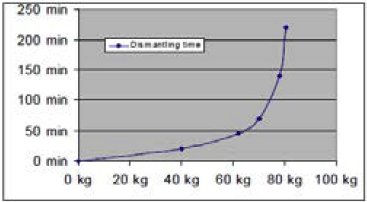
Figure 32 - Dismantling time for a car (total plastics 160kg) [42]
The availability, however, of advanced mechanical separation may offer a more cost effective recycling option and lead to plastic being left on (even though a higher quality material could be obtained with manual dismantling): "It is extremely unlikely, where advanced separation was used to obtain a mix of sorted plastic for recycling, that more expensive dismantling of plastic parts would take place" [43] .
Industry feedback, obtained during this project, suggests that manual dismantling of plastic parts is a very limited practice in the UK. Aside from the economics of labour rates versus time taken to remove the part, there are also potential issues with metal inserts (used as fastenings in bumpers) causing an issue with plastic recycling operations.
At levels of income varying between £125 and £175 for baled or crushed ELVs, as input material to a shredding operator, the value of material extracted (prior to selling to a shredder operator) has to exceed these amounts by a considerable margin to repay the labour cost of manual removal. It is only when items of high intrinsic value (or particularly sought after spare parts) are involved is the shift from shredding likely to be economical.
4.2 Current recycling and recovery equipment and practicesThis section describes the recycling and recovery equipment and practices currently used by ELV dismantlers and shredders in Scotland.
4.2.1 Depollution and dismantlingAs detailed in section 3.2.5, there are minimum mandatory depollution processes which must be carried out by ATFs to comply with legislation. Some of the key equipment used in the depollution process is described below.
Equipment used in the depollution process
There are many pieces of equipment available to aid the depollution process and all of these items are commonly used across Europe and the world. They include:
- Equipment which safely drills fuel tanks and hydraulically removes fuel;
- Drainage/collection equipment for oils, hydraulic fluids etc.; and to remove oil from shock absorbers;
- Tools to remove the catalytic converter;
- Equipment for removal and safe storage of air conditioning gases;
- Equipment for airbag detonation and;
- Equipment for removal of seat tensioners
Other Equipment Used by some Operators
Whilst most ATF's should have equipment for the depollution process, some operators have additional equipment; with the use of such extra equipment usually driven by the volumes handled. Examples include:
- Car Flattener
- Used to decrease volume when the hulk is transferred to the shredder operator. This helps lower the transport costs per tonne
- · Baling Machine
- Used for the above reasons and additionally enables a volume to be transported longer distances ( i.e. 20 bales on flatbed lorry). This provides ATFs the chance to sell to a wider selection of shredders to help achieve a higher price, although processing them tends to be more energy intensive than with flattened ELVs. Only viable if there is sufficiently high throughput of ELVs
- ·
JCB Grab/Engine Ripper
- Some operators remove the engine for recycling. This is carried out as the value of the engine scrap metal is higher than the hulk light iron price. Engines are sold in bulk to specialist operators. As with baling machines, this is only viable if volumes of ELVs are sufficiently high.
- · Wiring/Engine Ripper
- This equipment is new to the UK and is an American machine, marketed by a Scottish company. It enables operators to use a set of mechanical jaws to rip out small targeted parts whilst also being able to handle the full ELV. Again, the equipment is only viable if volumes of ELVs are sufficiently high. A cost analysis of this system was recently reported [44] :
"The whole idea of the [equipment] is to be able to separate the bulk (not every last little bit) of the high value metal quickly and efficiently from the elv. The data shows that the trained operator handles between 50 and 55 cars per day. This is down slightly from the 60 elv's per day claim in the original article, but then, this is what has happened over an extended period so we can assume that it is the realistic figure in an ongoing work environment.
From a starting point, let's take the total tonnage baled over the period which is 2367.83 tonnes. If this was baled as previously, all would have been sent to the shredder and the return would have been £414,063. That's baled, complete with engines, gearboxes etc. This figure is our default figure. What [the operator] would have achieved without any extra effort.
Using the [equipment], [the operator] separated the following quantities of materials into the following streams:
- Bales - 1993.28 tonnes = £348,171
- Steel (engines) - 183.94 tonnes = £53,061
- Aluminium Alloys (engines, gearboxes, ABS units) - 151.36 tonnes = £60,534
- Aluminium Alloys (heater matrixes, air con radiators and pipes) - 6.62 tonnes = £4,965
- Mixed Copper alloys (matrixes) - 0.9637 tonnes = £1,392
- Copper (matrixes) - 0.5599 = £1,512 tonnes
- Copper (wire) - 19.92 tonnes = £35,856
- Copper (brake pipes) - 0.1102 = £440
- Starters & alternators - 11.58 tonnes = £10,422 - removed manually after engines/gearboxes have been removed
The above tonnages and values are the actual figures that [the operator] achieved from the 2,482 ELVs processed and as such gives a reasonably accurate analysis and breakdown. Other factors that must be considered are that 436 of the vehicles had no engine, 424 had no gearbox and 90 had no wiring loom. When you add all these figures up, you get a difference in return of £124,318. The labour costs have been quantified at £11,590 and fuel used during the trial was £2,237. So, apart from the cost of the machine and maintenance costs (which should be included), there isn't much missing. When the fuel and labour are included you end up with an increase in return of £110,491 which represents a gain of just under 25%. Or to put it another way, that's an increased return per vehicle of £44.51".
Alongside the above equipment, some operators are purchasing machinery to granulate the copper wiring looms and selling the resulting copper for recycling (current value £4,000 per tonne as opposed to £1,500 per tonne for un-stripped cable). It should be noted, however, that the stripped cable weighs around 35% of the un-stripped cable. If this practice becomes widespread it is likely that shredder operators would reduce the price paid for scrap hulks without engine and wiring looms as they previously gained the financial benefit from recycling these materials.
4.2.2 Mechanical ShreddingAt the four shredding plants in Scotland which were interviewed, a typical approach used to deal with 'raw' input materials is illustrated below. This is the stage beyond depollution where items such as batteries and catalytic convertors have been removed manually:
- Incoming materials, whether baled, flattened or non-flattened (but depolluted) ELVs, or other light mixed scrap are stockpiled for processing through a hammer mill process
- The nature of inputs means that the operators tend to see the input as a metal resource rather than simply ELVs for processing (it is, therefore, mixed with other input materials in a continuous process)
- Having gone through the hammer mill process the 'balled' metal (see image overleaf) and other material can be further treated by magnetic and eddy current separation to realise further value by segregation of metals
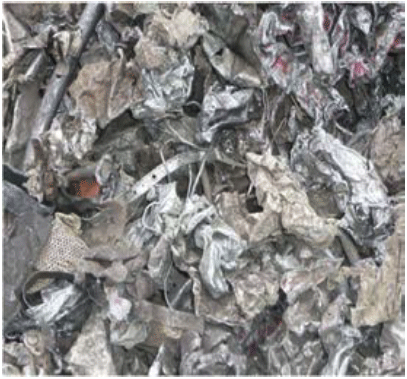
Processed light scrap (output from the hammer mill)
- After the magnetic and eddy current separation there is a degree of manual sorting, with a focus on high value items of non-ferrous metal such as remains of wiring looms (insofar as ATFs or initial scrap merchants have not already removed them)
- The mix of material goes through further shredding to take the 'balled' material to smaller size, allowing smaller size fractions of ferrous and non-ferrous metals to be identified, segregated and made ready for onward sale to processors/refiners
The remaining material is classed as automotive shredder residue ( ASR), which consists of 'fines' and a 'light fraction' as shown in the images overleaf.
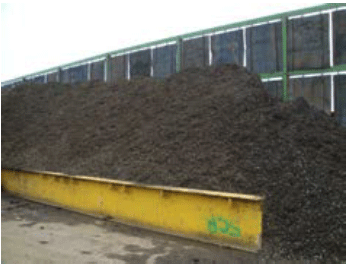
Fines
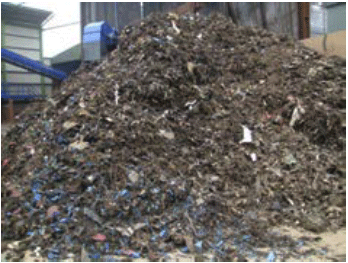
Light fraction
There is evidence of at least one shredder conducting pilots to hand sort non-metallic materials from the light fraction, for example, plastics and rubber, as shown in the images below.
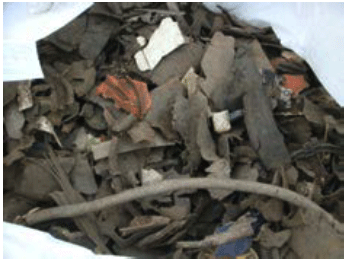
Plastics sorted from light fraction
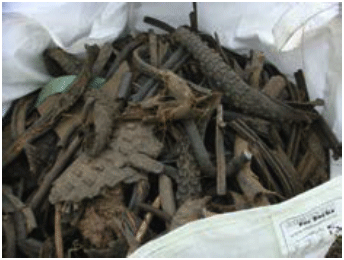
Rubber sorted from light fraction
These pilots demonstrated that the value generated from the separated materials (less the labour cost of sorting) was not sufficient to make the process economic, relative to disposal via landfill. Indeed, the shredder found very limited or no markets for the sorted plastics and rubber.
4.2.3 Post Shredder Treatment ( PST) of ASR
In Scotland there is ongoing work being carried out by shredders on the material processing capabilities of their plants. These additional processes are mainly more refined mechanical separation, including optical sorting. Some of these may mirror practices identified in figure 33, below [45] , which shows examples of technologies used across Europe. Technologies that are beginning to be used in Scotland include:
- Micro shredding/granulation
- Optical sorting
- Flotation and sinking tanks
- Further eddy current and magnetic separation
Use of these technologies can establish resource streams of ferrous metals, stainless steel and mixed non-ferrous metals, which are of higher value than simply leaving the larger sized 'balled' metal fraction intact. Beyond this metallic sorting, other technologies and processes are being investigated to deal with the fines, plastics, rubber, foams and wood, which are the main components of the residue.
It would appear that the shredder operators in Scotland are looking at elements of these waste streams and evaluating options to deal with them (for example, the pilot trial to hand sort plastics and rubber from the light fraction). This is, however, on more of a 'piece-meal' basis than what might happen at a purpose-built PST plant (such as those currently operating and being developed in England and overseas that are achieving, or getting close to, the 95% recovery level).
Shredders in Scotland highlighted approaches received from waste management companies with a view to using the ASR as a feedstock for Refuse Derived Fuel ( RDF) or Solid Recovered Fuel ( SRF). The UK Government position on the use of thermal treatment for ASR is that this can be counted as recovery subject to minimum thermal efficiencies being achieved [46] .
Whether there is a case for moving beyond current investment in Scotland to a purpose-built PST plant will be further explored in section eight of this report.
A number of PST technologies have been identified and these are summarised in figure 33.
Figure 33 - Overview of Post Shredder Technologies [47]
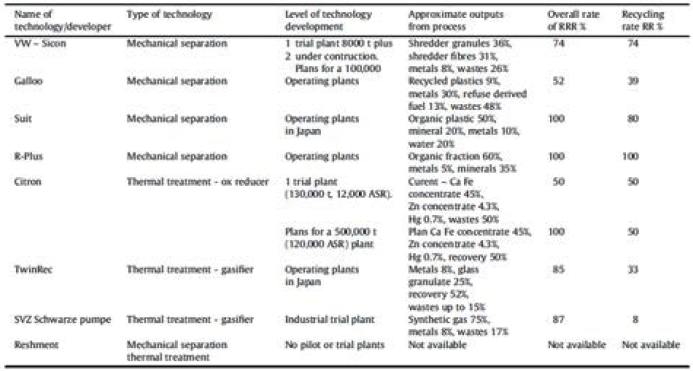
Figure 33 provides an overview of the main existing post shredder technologies and developers from around the world.
An example of an organisation currently operating mechanical separation plants is Galloo Plastics, a sister company of Belgium based Galloo Group. The Galloo Group operates ELV shredding plants and other recycling facilities in Belgium, the Netherlands and France. Their plastic recycling process involves [48] :
- Grinding ASR to a 25mm size
- Wet density separation (provided by US company Engineering and Separation Technology LLC)
- Size classification
- Air classification
- Eddy current separation (to remove remaining metals)
Galloo Plastics claims it is set to produce 25,000 tonnes of granulate per year (from end of life consumer electronics and ELV). It exports 40% of this material from its French plant, mainly to Europe (including for use in vehicle production) but also to Brazil and Mexico.
Figure 34, below, provides a summary of the processes used in various PST operations.
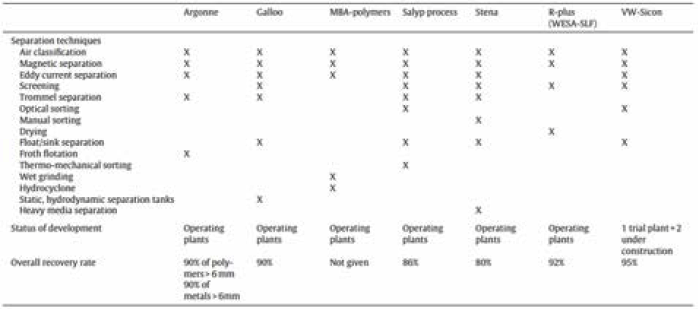
Figure 34 - Overview of processes used in post shredder technologies [49]
The new ASR facility, being developed in the Netherlands (with investment provided via their ELV funded system), uses VW-Sicon technology and plastics are sent for onward processing at Galloo.
In addition to the PST technologies summarised above, the following systems are also of interest [50] :
Agilyx
Agilyx ( www.agilyx.com) are based in Oregon in the US. The company claims to have a patented technology to convert plastic waste into a synthetic crude oil. The plant is said to be capable of processing ten tonnes of plastic per day (to produce 2,400 gallons of oil). Capacity can be increased by adding to the modularised system.
Vadxx
Vadxx ( www.vadxx.com) claims to have developed a technology that can convert ASR into a synthetic crude oil, a natural gas and a carbon char product. The company further claims that the system can breakeven at crude oil prices of between $35 and $40 per barrel (less than half the current oil price at the time of writing).
Chinook Sciences
Chinook Sciences ( www.chinooksciences.com) is a US based company that claims to have a patented gasification technology that can process ASR. Chinook has an office in Nottingham due to 'considerable interest' from the UK market and provides technology to one of the large shredders in the UK.
The PST plant modelled as part of this project (and described in section eight) is based on feedback from two operational PST plants. In both cases the minimum commercially viable throughput of shredder residue is 100,000 tonnes per annum and the investment cost was between £20 million and £25 million. A third plant was identified, via secondary information sources, with a stated commercially viable capacity of 60,000 tonnes. Despite attempts to make contact with the operator of this plant we were unable to obtain more detailed feedback in the time available.
4.2.4 Recycling and recovery technologies to extract valuable metals and rare earth elementsHigh value metals
The recovery of high value metals is a well established part of the ELV sector, as described in section 6.3. The technologies used to extract high value metals are either pyrometallurgical ( e.g. smelting and refining) or hydrometallurgical ( e.g. using chemicals to separate and extract metal types). The facilities that carry out this high value metal extraction are characterised by large physical footprints and high capital investment costs. There are, therefore, relatively few facilities in Europe, with only one being identified in the UK (that extracts platinum group metals from catalytic convertors).
Rare earth elements
'The recycling of rare earth elements from electronic devices, for example, is currently challenging from a technological but also from an economic point of view.....this situation calls for targeted innovation and research efforts, breakthrough technologies and multidisciplinary approaches to bridge gaps in our knowledge' [51] .
One of the main issues in extracting rare earth elements is that they are present in small amounts in parts and components and this concentration is diluted even further when faced with a volume of shredder residue. The level of input material required to obtain commercially viable levels of rare earth element recycling is significant, with one Japanese company seeking to commercially process 100 magnets per hour in its new plant (see over page for more detail).
Rare earth elements are present in a number of parts and components. A recent study, conducted jointly by Ford and Massachusetts Institute of Technology identified the 12 parts and components containing rare earth elements and their respective rare earth element content [52] . Figure 35, below, summarises this data.
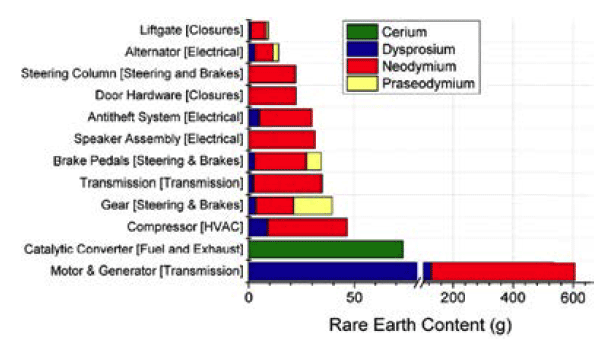
Figure 35 - Top 12 vehicle parts containing rare earths and their rare earth content
The study estimated that there was 0.44kg of rare earth elements in a 'typical mid range US sedan' and that 80% of this was contained within magnets. For a full hybrid vehicle with a lithium ion battery, the estimated weight of rare earth metal content rose to 1.05kg per vehicle (obviously the additional amount of rare earth elements being contained in the battery). A full hybrid with a nickel metal hydride battery was estimated to have a rare earth element content of 4.5kg per vehicle (again with the additional amount of rare earth elements being contained in the battery).
A search of technologies capable of extracting rare earth elements has identified a number of pre commercial developments in Japan, where the government has set aside some $1.2bn for research into rare-earth recycling, as well as opening new supply routes and stockpiling rare earth elements. The government is also drafting legislation to promote the re-use of rare earth elements from used products [53] . Kosaka Smelting and Refining (a subsidiary of Dowa Holdings) is attempting to recover rare earth elements, such as neodymium, using a smelting a refining process [54] . Hitachi is working on a dry extraction process to recover neodymium and dysprosium from rare earth magnets. This facility is expected to be fully operational in 2013, automatically processing 100 magnets per hour compared to ten magnets per hour using a manual process. The company is targeting a 10% recycling rate for rare earth elements by 2013 [55] . Toyota is working jointly on the issue with Panasonic to recycle lanthanum and neodymium from hybrid vehicle batteries (this also involves joint working with SNAM in France). Honda is working jointly with Japan Metals & Chemicals to establish a large scale facility to recapture rare earth elements from Honda parts (with claims that up to 80% of rare earth elements can be recovered from nickel metal hydride batteries) [56] .
Umicore, a major Belgium based metal refiner, has also developed a process for recycling rare earth elements from nickel metal hydride rechargeable batteries [57] .
A German led partnership project ( MORE - MOtor REcycling) has been funded by the German Federal Research Ministry. The project is led by Siemens and also involves Daimler, Umicore and several universities and research institutions. The objective is to investigate different approaches to the recycling of electric motors from vehicles, such as: the dismantling of the magnets; the repair, refurbishment and reuse of the electric motor or its components; and the recycling of magnetic materials and rare earth recovery from pre-sorted and shredded material [58] .
GreenRock Rare Earth Recovery Corporation, in the US, plans to establish four rare earth recovery facilities processing 277,000 tonnes of consumer electronics, magnets, phosphors and industrial batteries per annum [59] .
In Norway, the state research organisation has funded a project to develop techniques for extracting rare earth elements from permanent magnets. The project is investigating the potential of technology transfer from the aluminium smelting industry [60] .
Contact
There is a problem
Thanks for your feedback